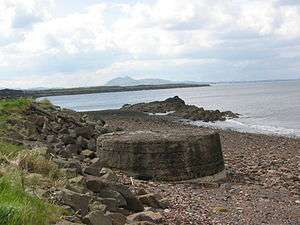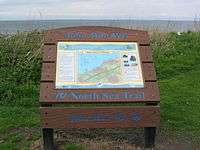Morrison's Haven
Morrison's Haven (or Morison's Haven) is a harbour at Prestongrange, East Lothian, Scotland, UK, on the B1348, close to Levenhall Links, Prestongrange Industrial Heritage Museum, Prestonpans, and Prestongrange House.

History
In 1526, the Cistercian monks of Holyrood Abbey and Newbattle Abbey received permission from King James V for the construction of a port in place called "Gilbertis-draucht". The Abbot leased the port to Alexander Atkinsoun or Achesoun, and the port was known as Acheson's Haven and sometimes "New Haven" until the 17th century. The monks could also collect "port monies, customs and duties". There was at least one mill, and a stone fort with underground vaults which was destroyed by Oliver Cromwell in 1650 on his way to Leith.
The harbour was used to load building materials for the fort on Inchkeith in 1555. During the Scottish Reformation, in April 1560 English troops commanded by Lord Grey de Wilton marched from Berwick upon Tweed to join the Siege of Leith. Passing through Dunglass and East Linton, the English army camped at Prestongrange on 4 April where the lighter artillery pieces for the siege were landed from ships at Acheson's Haven.[1]
The harbour was managed by Mark Acheson of Acheson's Haven who in 1587 undertook to pay custom duties for salt exports to John Chisholm, comptroller of the Royal Artillery.[2] In 1591 Euphame MacCalzean was convicted of witchcraft on several charges including attending an assembly of witches at "Atkynson's Haven" where an image of James VI was given to the devil for the destruction of the king.[3]
By the middle of the 18th century, the Haven was a busy port, exporting oysters, salt, local glassware, ceramics, bricks, fireclay, coal, and chemicals, including sulphuric acid. Imports were brandy from France, port wine from Portugal, Delft china from the Low countries, leather from the Baltic port Danzig, and furs from Canada. A map of 1773 shows the port having two breakwaters.
The importance of the Haven is reflected in the fact that it has customs jurisdiction over the coastline from Figgate Burn, Portobello all the way to the Tyne at Belhaven.
In the late 19th century, ships from the Baltic brought rock salt to Morrison's Haven and exchanged it for coal and other commodities.
Up to the late 1920s, the Haven exported large amounts of coal and bricks. Then it became disused, and the harbour was filled in and the site was landscaped. At the same time, Prestongrange's traditional industries declined apace.
Masons and Freemasons
There was a stonemasons' lodge in existence at Acheson's Haven from at least 1599. The written records of this lodge commence on 9 January 1599. Over time the 'operative' stonemasons admitted men who were not stonemasons and by the early 18th century it was recognisably a Masonic Lodge. The Lodge's Minutes are therefore the oldest records in the world of a Masonic Lodge. Although this lodge was represented at the foundation meeting of the Grand Lodge of Free and Accepted Masons of Scotland, on 30 November 1736, it decided not to participate and remained independent until 1814 when it finally become a daughter Lodge of the Grand Lodge of Scotland. The Lodge ceased to function in 1853. The Minute Books of the Lodge were put up for auction by descendants of the last Lodge Secretary and were purchased by the Grand Lodge of Scotland in July 1980.[4]
Morrison's Haven today
The Prestongrange Community Archaeological Project, started in 2004, confirmed the importance of Morrison's Haven. 18th century glass and pottery manufacture was totally dependent on the harbour. It developed into a mechanised working port and underwent frequent repair and improvement. The PCA Project enabled local residents to learn skills related to archaeology.

The Haven is on the route of the John Muir Way, a long-distance footpath along the East Lothian coast, starting at Fisherrow and terminating at Dunglass.
References
- Calendar State Papers Scotland, vol. 1 (Edinburgh, 1898), pp. 340-346.
- David Masson, Register of the Privy Council of Scotland: 1585-1592, vol. 4 (Edinburgh, 1881), p. 193.
- Calendar of State Papers Scotland, vol. 10 (Edinburgh, 1936), p. 530.
- The Grand Lodge of Scotland Year Book. 1981. pp 58-66
- Shirlaw, Jean H., "The glassworks at Morrison's Haven", Transactions of the East Lothian Antiquarian % Field Naturalists's Society, 24 (2000), 39-40. ISSN 0140-1637
External links
- Overview of Morrison's Haven, by East Lothian Museum Services
- Report No. 937, Prestongrange Community Archaeological Project
- "Acheson/Morrison's Haven - What came and went and how" by Julie Aitken
- Gazetteer for Scotland, Historical perspective, drawn from the Ordnance Gazetteer of Scotland, ed. Francis H. Groome, publ. 1882-85 Thomas C. Jack, Grange Publishing Works, Edinburgh
- PDF Leaflet "Happy Walks in Prestonpans", featuring Morrison's Haven